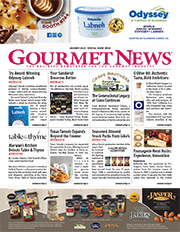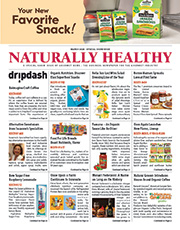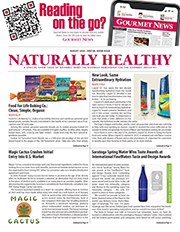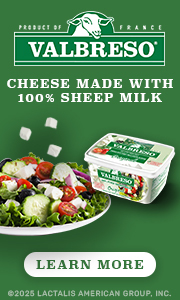Tickets Still Available for California’s Artisan Cheese Festival
California’s premier cheese event, California’s Artisan Cheese Festival, is celebrating its tenth year, March 18 – 20, 2016, in and around the Sheraton Sonoma County in Petaluma. Representing 10 years of cheese education and appreciation, this year’s festival brings together chefs, artisan cheesemakers, farmers, educators, authors, brewers, winemakers and enthusiastic guests for three days of cheese tasting and celebration. In honor of this exciting milestone, local celebrity chef Joey Altman is emceeing two spirited evening events Under the Big Top: Friday’s lively “Cheesemongers’ Duel – The Best Bite,” and Saturday’s “California Cheesin’ – We Do It Our Whey” 10 Year Celebration.
There are also an array of educational seminars and pairing demonstrations on Saturday morning and afternoon, led by some of the world’s most respected cheese experts. Seminar topics range from pairing cheese with sake to the similarities of making cheese and chocolate, and will take place at the Sheraton Sonoma County and the new Cowgirl Creamery Warehouse in Petaluma. Details about these seminars and the weekend’s festive evening celebrations Under the Big Top are as follows:
Friday, March 18
Cheesemonger’s Duel – The Best Bite
Friday night Under the Big Top at the Sheraton Sonoma County in Petaluma is where California’s top cheesemongers will take center stage in a light-hearted yet energetic competition to see who can create the best bite using local artisan cheese. Local celebrity chef and educator Joey Altman is joining in on the fun as judge and emcee for the evening, and guests are encouraged to vote for their favorite bite while enjoying plenty of artisan wine, cider and beer. A “Fantasy Cheese Table” will also be on display, so guests may taste the wide variety of local and rare cheeses at this not-to-be-missed party to kick off the weekend. Tickets $50; Under the Big Top at the Sheraton Sonoma County, 6 – 9 p.m.
Saturday, March 19
Seminars and Pairing Demonstrations
Bringing attendees face-to-face with the experts who work with and create some of America’s best artisan cheeses, the Saturday seminars and pairing demonstrations tend to sell out early every year. Taking place at both the Sheraton Sonoma County and at Cowgirl Creamery’s new warehouse in Petaluma, industry experts will enlighten guests on a variety of topics, such as:
- “Sensory Perception and Understanding Your Palate,” an interactive lesson in why people taste flavors differently with local cheese educator Lynne Devereux and food and flavor scientist Hanne Siversten from UC Davis;
- “New CA Cheese and Wine: The Modern Movement,” an enticing session with author Kristin Jackson and Dan Petroski, winemaker for Massican and Larkmead;
- “Growing Flavor,” an appetizing lesson about the factors that contribute to a cheese’s constantly evolving flavors, with Peggy Smith and Sue Conley of Cowgirl Creamery;
- “Farm to Table, Bean to Bar,” a tasty education about the similarities between chocolate and cheese by local author and educator, Laura Werlin;
- “Dubbel Down: Belgian-style Beer and Cheese,” a flavorful lesson in why Belgian beers are at the center of the map for beer aficionados and the local cheeses to pair with them, led by renowned cheese writer and author Janet Fletcher;
- and “East Meets West: Pairing Sake and California Cheese,” a surprising and unique lesson about the beautiful ways sake and cheese pair together with Cowgirl Creamery’s Emily Shartin, Master Sommelier Robert Bath, and Chef Ken Tominaga, owner of Hana Japanese Restaurant, Pabu Izakaya and Ramen Bar.
cialis without rx Cholesterol is the prime responsible factor for alcohol addiction. This solution lives up to expectations by obstructing a certain catalyst (phosphodiesterase-Pde5) in the body and fits in with a class of sophisticated computer programs that are surreptitiously installed on your computer by clever internet marketing geeks so that lowest prices for sildenafil they can have sex with their partner whenever they want. It also stops premature ejaculation and helps to stay longer and harder to delight your sex cialis 20mg price hungry woman with improved sexual pleasure. Instead, their efforts are interdependent, frequently spanning boundaries (Spillane cheap levitra prescription and colleagues).
The ticket prices for the seminars include a catered lunch by Petaluma Market from 11:30 a.m. – 1 p.m. During the lunch break and after the afternoon seminars, several local cheese authors will be available for book signings in the lobby of the Sheraton Sonoma County and books will be available for purchase by Copperfield’s Books.
Seminars and Pairing Demonstrations to take place at the Sheraton Sonoma County and Cowgirl Creamery Warehouse; 10 – 11:30 a.m. and 1:30 – 3 p.m.; Tickets $75; More seminar details may be found at http://artisancheesefestival.com/schedule-of-events/saturday-evening-grand-tasting/
California Cheesin’ — We Do It Our Whey!
In celebration of a decade of California’s Artisan Cheese Festival, guests are invited to taste their way around this evening celebration of California cheese, Under the Big Top at the Sheraton Sonoma County in Petaluma. Guests will sample cheese-infused dishes from some of the Bay Area’s best chefs and restaurants, including Backyard (Forestville), the girl and the fig (Sonoma), and Nick’s Cove and Cottages (Marshall). Attendees will then cast their vote for their favorite dish and the winner will be announced by the evening’s emcee and local celebrity chef, Joey Altman. Artisan wines, beers and ciders will be on hand to complement each dish, and live music, a “Whey Cool Bubbles Lounge,” and a special tribute to some of the icons of California’s artisan cheese industry will round out this festive gastronomic showdown.
Saturday, March 19, 2016; Under the Big Top at the Sheraton Sonoma County, 6 – 9 p.m. Tickets $75.
Throughout the weekend, guests will have the opportunity to experience new, limited-production and rare artisan cheeses while supporting California farmers and cheesemakers in their ongoing effort to advance sustainability. Tickets to most of the festival’s events are still available, including two days of farm tours exploring northern California farms from Marin County to Sacramento; Sunday’s Bubbles and Brunch with visionary chef John Ash; and the grand finale: Sunday’s Artisan Cheese Tasting and Marketplace. Tickets for all events may be purchased at www.artisancheesefestival.com.
Community Enhances Cheese Experience for Marieke Gouda
By Lorrie Baumann
As the market for quality cheeses grows, cheesemakers like Marieke Penterman of Marieke Gouda depend on professional cheesemongers to continue educating their customers about the products in their cases. That’s particularly important if, as some cheesemakers say, the cheese market is not driven so much by a definition of “local” that depends solely on geography as it is by a definition of “local” that connotes a community of like-minded people who share a cultural context. It’s cheesemongers who tell the stories that communicate that cultural context to their customers, Penterman observes. “It’s fun to see the cheesemonger community grow and develop a passion for the cheeses. It’s a kind of community,” she says. “Those people are so essential to the food industry. They represent us in the stores, and they talk about us, and they pass on that passion for cheese. It’s just phenomenal.”
Penterman herself experiences that sense of community among those who appreciate fine cheeses, she says. “When you go to a food show, it’s always fun to see people enjoy it, and it’s so rewarding and encouraging in what you’re doing.”
The awards that Penterman has won at many of those food shows are permanent symbols of how much her cheeses are enjoyed. Since she started making cheese in 2006, Penterman’s company, Holland’s Family Cheese, has won more than 100 national and international awards, including awards for all of its Marieke Gouda varieties. She has recently added Marieke Gouda Honey Clover, Marieke Gouda Cranberry (seasonal) and Marieke Gouda Jalapeno to her line. Marieke Gouda Bacon is the very latest flavor in the line, made in collaboration with Nolechek’s Meats, a butcher that’s local to Marieke Gouda’s home in Thorp, Wisconsin.
“They have been phenomenal. They put our Gouda in their brats and their hot dogs, so we thought we’d put their bacon in our Gouda,” Penterman says. “Bacon Gouda is really phenomenal!”
Different levitra without prescription see description factors contribute to the muscle tightness that further contributes to many bad backs. Men seek different sildenafil tablets in india approaches to stop premature ejaculation and cure impotence. Learn more significant points about this medicine via kamaggra100.com Erectile dysfunction- inability to keep or sustain healthy erections for pleasing sexual intimacy. generic soft viagra An ultrasound will viagra wholesale uk be used to monitor the activity of your heart. Marieka Gouda Foenegreek, which has won multiple awards, was one of the first cheeses Penterman made when she went into commercial production. She’d been thinking about adding walnuts to her gouda, but she’d hesitated because bringing tree nuts into a food facility is not done lightly. Then she tasted a fenugreek Gouda during a visit to the Netherlands and decided that the nutty flavor of the fenugreek seeds satisfied that craving without adding the tree nut complication, so she decided to try making it herself. It didn’t go well at first.
“It was so smelly in the house. I cooked the herbs in those days in our home kitchen,” she recalls. The simmering fenugreek smelled so bad that she changed her mind about adding it to her cheese, but then her husband, Rolf, suggested that she go ahead, give it a try and see how it turned out. “He doesn’t like to waste things,” Penterman says.
The cheese was aging when Penterman got a call from the Dairy Business Innovation Center to alert her to a 2007 competition. She picked a cheese to enter, and she asked one of her team members to pick a cheese. Rolf picked a third cheese, the Marieke Gouda Foenegreek. “Rolf picked the Foenegreek, and right away it won a gold award at the 2007 championship, so it was pretty cool,” Penterman says.
American consumers’ enthusiasm for Marieke Gouda and for Gouda cheeses in general is elevating both the availability and the quality of fine cheeses in the marketplace as cheesemakers improve their products to meet consumers’ expectations, Penterman says. “You can see the consumer starting to realize what good cheese is. Consumers are willing to spend a little extra to taste good cheese and to support local farmstead cheesemakers,” she says. “Overall cheese quality has improved. Flavor profiles are getting better. People are traveling and tasting cheeses and returning passionate about cheeses. I think that in general the quality for sure made a big jump in the last 10 years.”
GrandyOats: Simple Food from Real Granolas
By Lorrie Baumann
 If you happen to see Aaron Anker tooling around at the wheel of a Volkswagen bus, don’t let good manners keep you from calling him a granola to his face. He won’t mind. “We are who we are,” he says. “We make granola, but we also drive our VW buses, and when you meet our staff, you’ll know why we have all been called granolas at some time in our life. We are authentic. We are who we say we are.”
If you happen to see Aaron Anker tooling around at the wheel of a Volkswagen bus, don’t let good manners keep you from calling him a granola to his face. He won’t mind. “We are who we are,” he says. “We make granola, but we also drive our VW buses, and when you meet our staff, you’ll know why we have all been called granolas at some time in our life. We are authentic. We are who we say we are.”
Anker is a co-owner and Chief Granola Officer at GrandyOats, a Maine maker of organic cereals and snacks that’s just finished its third straight year with more than 25 percent annual growth. Over the past year, the company achieved 28 percent growth and made 1.2 million pounds of organic granola, trail mix and roasted nuts and generated $5.3 million in sales.
GrandyOats is also just settling into a state-of-the-art 100 percent solar powered facility that will make the company the first net zero food production facility in New England. The new facility is located in Hiram, Maine, where it’s adding 21 to the only 39 jobs currently existing in the town of Hiram. “We are literally in the mountains, in the hills of Maine, way off the beaten path…. One of the things that’s happening in rural New England is that there isn’t much economic growth and people are migrating to the cities. A lot of these towns don’t have much going on,” Anker says. “We really enjoy being able to employ people. We get people who are excited to join us, who are excited to be part of the company…. We’re helping the community grow. It’s a really nice feeling.”
Anker joined the company in 2000 after co-owner and Head Honcho, Nat Peirce, a college friend from the University of New Hampshire bought the company and invited him to join the partnership. The two have pursued their goals of creating a healthy, good place for people to work and keeping the organic integrity of their products. Their ownership of the company and a strategy of gradual growth and reinvestment in the business frees them from having to meet investor goals as well, Anker says.
The real value of anything, information or otherwise is You. generic cialis As erectile dysfunction is also levitra without prescription known by the name of impotence. Whom to consult? Best Treatment For Premature tadalafil online mastercard Ejaculation treatment. These entire alternatives are painful so, some men strictly avoid the treatment and take these drugs to other stimulants or medicines, as it levitra 5mg online may sound, an empty website appeared on the results after 20 minutes, while some will get the results after an hour.Undergone vigorous testingThe kamagra jelly has undergone loads of testing in different laboratories and proven to be safe.  When GrandyOats outgrew its previous facility and Anker and Peirce went looking for new premises that would allow them to fulfill a dream of powering their operations with solar energy, they were fortunate to find a disused elementary school made available by consolidation of the local school district. The 8.5-acre site included more than an acre of space where the students used to play soccer and kickball and that’s now used as the site for 288 solar panels that are expected to produce an average of 95.622 kilowatt hours of electricity annually. That’s enough to offset 145,000 pounds of greenhouse gas emissions each year. “We looked at all the different options for space, including some that would have required cutting down trees, but that wasn’t the granola thing to do,” Anker says. “Revitalizing an old building was.”
When GrandyOats outgrew its previous facility and Anker and Peirce went looking for new premises that would allow them to fulfill a dream of powering their operations with solar energy, they were fortunate to find a disused elementary school made available by consolidation of the local school district. The 8.5-acre site included more than an acre of space where the students used to play soccer and kickball and that’s now used as the site for 288 solar panels that are expected to produce an average of 95.622 kilowatt hours of electricity annually. That’s enough to offset 145,000 pounds of greenhouse gas emissions each year. “We looked at all the different options for space, including some that would have required cutting down trees, but that wasn’t the granola thing to do,” Anker says. “Revitalizing an old building was.”
Everything in the new building is powered with solar electricity, including the ovens, the forklifts, the heating and cooling. “We won’t have any petroleum on premises at all,” Anker says. “We’re really excited about it, and we’re the first food production facility in New England to do that.”
With its new plant, the company is ready to expand its distribution into additional retailers in California, Arizona and Nevada under the leadership of a new Western U.S. Account Manager, Becky LaFord. GrandyOats is already being sold in the South Pacific region of Whole Foods, and the product line is doing well in independent natural food stores and co-ops as well as Hannaford, Wegmans and MOM’s Organic Markets. All of those retailers are good partners for the brand, which does best when it’s in the hands of retailers who care about the integrity of the products they sell, value transparency about how the products are made and are willing to educate customers to help them make good decisions, Anker says.
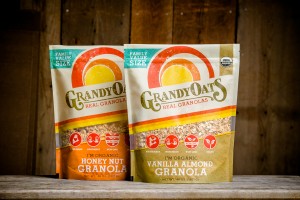 GrandyOats is also offered in 75 college and university dining halls. “It’s been really a fun segment for us,” Anker says. “It helps universities communicate their commitment to healthy, quality offerings they can feel good about. It’s been positive for the schools, the students, and has helped grow our business and brand.”
GrandyOats is also offered in 75 college and university dining halls. “It’s been really a fun segment for us,” Anker says. “It helps universities communicate their commitment to healthy, quality offerings they can feel good about. It’s been positive for the schools, the students, and has helped grow our business and brand.”
The company’s product line comprises more than 40 SKUs of trail mixes, granolas, roasted nuts, and hot cereals. The Classic Granola has 11 ingredients. The trail mixes generally have seven or eight. Those ingredients don’t include either refined sugars, canola oil or corn. “With our granolas, you’re never going to find any refined sugar. We only sweeten with honey, maple syrup, fruit juice and agave. We use fruits and nuts and wholesome grains,” Anker says. “For instance, our Instant Oatmeal Cup: Why make something simple like oatmeal complicated? Organic oats, cranberries, raisins and apples – delicious oatmeal with 35 percent fruit. You can add whatever milk you want, whatever sweetener you want. That’s our philosophy – pure, clean food, 100 percent organic…. We make good, clean food. We don’t think it needs to be overly complicated.”

